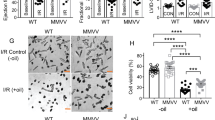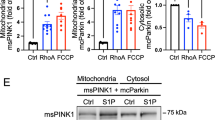Abstract
Reactive oxygen species (ROS) have been identified as central mediators in certain signalling events1,2,3,4. In the heart, ROS have important functions in ischaemia/reperfusion-induced cardiac injury5,6 and in cytokine-stimulated hypertrophy7. Extracellular signal-regulated kinase (ERK) is one of the ROS-responsive serine/threonine kinases. Previous studies showed that tyrosine kinases and small G proteins are involved in the activation of ERK by ROS4,8; however, the initial target protein of ROS that leads to ERK activation remains unknown. Here we show that inhibition of the βγ-subunit of G protein (Gβγ) attenuates hydrogen peroxide (H2O2)-induced ERK activation in rat neonatal cardiomyocytes. The Gβγ-responsive ERK activation induced by H2O2 is independent of ligands binding to Gi-coupled receptors, but requires phosphatidylinositol-3-kinase and Src activation. In in vitro studies, however, treatment with H2O2 increases [35S]GTP-γS binding to cardiac membranes and directly activates purified heterotrimeric Gi and Go but not Gs. Analysis using heterotrimeric Go and its individual subunits indicates that H2O2 modifies Gαo but not Gβγ, which leads to subunit dissociation. We conclude that Gαi and Gαo are critical targets of oxidative stress for activation of ERK.
This is a preview of subscription content, access via your institution
Access options
Subscribe to this journal
Receive 51 print issues and online access
$199.00 per year
only $3.90 per issue
Buy this article
- Purchase on Springer Link
- Instant access to full article PDF
Prices may be subject to local taxes which are calculated during checkout




Similar content being viewed by others
References
Lander, H. M., Ogiste, J. S., Teng, K. K. & Novogrodsky, A. p21ras as a common signaling target of reactive free radicals and cellular redox stress. J. Biol. Chem. 270, 21195–21198 (1995).
Sundaresan, M., Yu, Z.-X., Ferrans, V. J., Irani, K. & Finkel, T. Requirement for generation of H 2O2 for platelet-derived growth factor signal transduction. Science 270, 296–299 (1995).
Yin, Y. et al. Involvement of p85 in p53-dependent apoptotic response to oxidative stress. Nature 391, 707– 710 (1998).
Aikawa, R. et al. Oxidative stress activates extracellular signal-regulated kinases through Src and Ras in cultured cardiac myocytes of neonatal rats. J. Clin. Invest. 100, 1813–1821 (1997).
Granger, N. & Korthuis, R. J. Physiologic mechanisms of post-ischemic tissue injury. Annu. Rev. Physiol. 57, 311 –332 (1995).
Downey, J. M. Free radicals and their involvement during long-term myocardial ischemia and reperfusion. Annu. Rev. Physiol. 52, 487 –504 (1990).
Nakamura, K. et al. Inhibitory effects of antioxidants on neonatal rat cardiac myocyte hypertrophy induced by tumor necrosis factor-α and angiotension II. Circulation 98, 794– 799 (1998).
Sugden, P. H. & Clerk, A. Cellular mechanisms of cardiac hypertrophy. J. Mol. Med. 76, 725–746 (1998).
Luttrell, L. M. et al. Regulation of tyrosine kinase cascade by G-protein-coupled receptors. Curr. Opin. Cell. Biol. 11, 177 –183 (1999).
Koch, W. J. et al. The binding site for the βγ subunits of heterotrimeric G proteins on the β-adrenergic receptor kinase. J. Biol. Chem. 268, 8256–8260 ( 1993).
Miyake, S. et al. Efficient generation of recombinant adenoviruses using adenovirus DNA-terminal protein complex and a cosmid bearing the full-length virus genome. Proc. Natl Acad. Sci. USA 93, 1320– 1324 (1996).
Kurose, H. in G Protein-Coupled Receptors. (eds Haga, T. & Berstein, G.) 185–210 (CRC Press LLC, Boca Raton Florida, 1999).
Koch, W. J. et al. Cellular expression of the carboxyl terminus of a G protein-coupled receptor kinase attenuates Gβγ-mediated signaling. J. Biol. Chem. 269, 6193–6197 (1994).
Wilkins, J. F. et al. Regulation of the kinetics of phosducin phosphorylation in retinal rods. J. Biol. Chem. 271, 19232– 19237 (1996).
Delmas, P. et al. βγ dimers derived from Go and G i proteins contribute different components of adrenergic inhibition of Ca2+ channels in rat sympathetic neurons. J. Physiol. 518, 23–26 ( 1999).
Coffer, P. J. et al. Protein kinase B (c-Akt): a multifunctional mediator of phosphatidylinositol 3-kinase activation. Biochem. J. 335, 1– 13 (1998).
Sonoda, Y. et al. FAK is the upstream signal protein of the phosphatidylinositol 3-kinase-Akt survival pathway in hydrogen peroxide-induced apoptosis of a human glioblastoma cell line. J. Biol. Chem. 274, 10566–10570 (1999).
Howe, L. R. & Marshall, C. J. Lysophosphatidic acid stimulates mitogen-activated protein kinase activation via a G-protein-coupled pathway requiring p21ras and p74raf-1. J. Biol. Chem. 268, 20717–20720 (1993).
Albas, J. et al. Gi-mediated activation of the p21 ras-mitogen-activated protein kinase pathway by alpha 2-adrenergic receptors expressed in fibroblasts. J. Biol. Chem. 268, 19196–19199 (1993).
Mochizuki, N. et al. Activation of the ERK/MAPK pathway by an isoform of rap1 GAP associated with Gα1. Nature 400, 891–894 (1999).
Bauerle, P. A. & Baltimore, D. NF-κB: Ten years after. Cell 87, 13– 20 (1996).
Semenza, G. L. Perspective on oxygen sensing. Cell 98, 281–284 (1999).
He, T.-G. et al. A simplified system for generating recombinant adenoviruses. Proc. Natl Acad. Sci. USA 95, 2509– 2514 (1998).
Yamashita, N. et al. Heat shock-induced manganese superoxide dismutase enhances the tolerance of cardiac myocytes to hypoxia-reoxygenation injury. J. Mol. Cell. Cardiol. 29, 1805–1813 (1997).
Isogaya, M. et al. Identifiation of a key amino acid of the β2-adrenergic receptor for high affinity binding of salmeterol. Mol. Pharmacol. 54, 616–622 ( 1998).
Ruiz-Avila, L. et al. Coupling of bitter receptor to phosphodiesterase through transduction in taste receptor cells. Nature 376, 80– 85 (1995).
Katada, M., Oinuma, H. & Ui, M. Two guanine nucleotide-binding proteins in rat brain serving as the specific substrate of islet-activating protein, pertussis toxin. J. Biol. Chem. 261, 8182–8191 ( 1986).
Kim, K.-O. et al. Protection from reoxygenation injury by inhibition of racl. J. Clin. Invest. 101, 1821– 1826 (1998).
Acknowledgements
We thank T. Katada for providing the purified heterotrimeric proteins (Gi, Go, Gs) Gαo and Gβγ. We thank RIKEN DNA Bank for recombinant adenovirus for LacZ. We also thank I. Saito for cosmid vector for the COS–TPC method, and T.-G. He for plasmids of pAdEasy system.
Author information
Authors and Affiliations
Corresponding author
Supplementary information
Rights and permissions
About this article
Cite this article
Nishida, M., Maruyama, Y., Tanaka, R. et al. Gαi and Gαo are target proteins of reactive oxygen species. Nature 408, 492–495 (2000). https://doi.org/10.1038/35044120
Received:
Accepted:
Issue Date:
DOI: https://doi.org/10.1038/35044120
This article is cited by
-
A highly selective and sensitive upconversion nanoprobe for monitoring hydroxyl radicals in living cells and the liver
Science China Life Sciences (2021)
-
ROS and diseases: role in metabolism and energy supply
Molecular and Cellular Biochemistry (2020)
-
Connexin 43 and ATP-sensitive potassium channels crosstalk: a missing link in hypoxia/ischemia stress
Cell and Tissue Research (2018)
-
Papain gel containing methylene blue for simultaneous caries removal and antimicrobial photoinactivation against Streptococcus mutans biofilms
Scientific Reports (2016)
-
Chlorogenic acid analogues from Gynura nepalensis protect H9c2 cardiomyoblasts against H2O2-induced apoptosis
Acta Pharmacologica Sinica (2016)
Comments
By submitting a comment you agree to abide by our Terms and Community Guidelines. If you find something abusive or that does not comply with our terms or guidelines please flag it as inappropriate.



